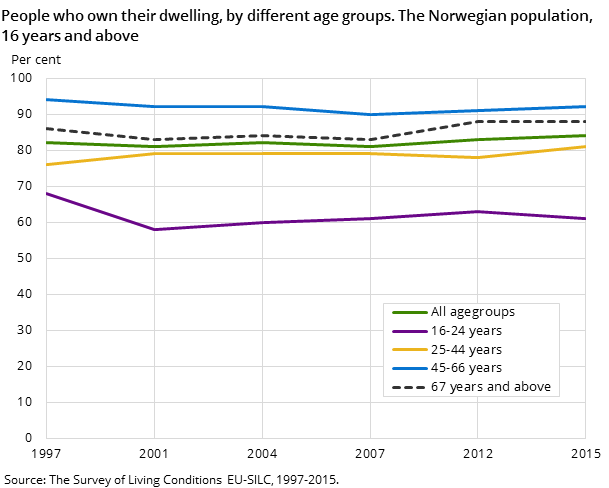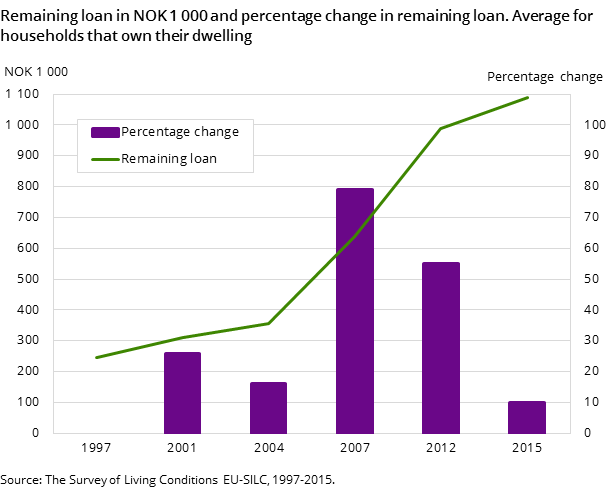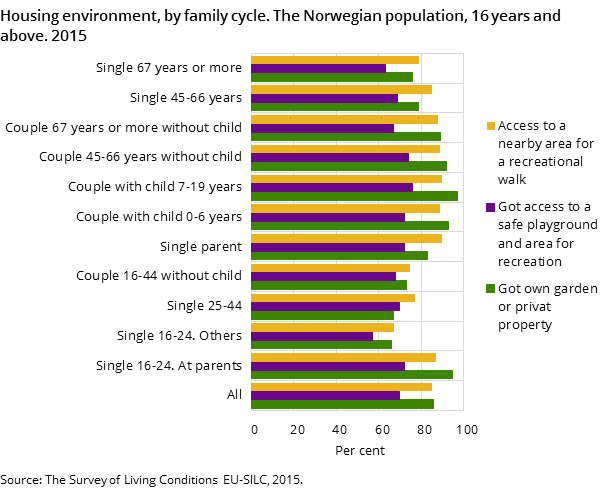Content
Published:
This is an archived release.
Decreasing growth in total housing cost
Most households own their own dwelling, and in 2015, the average mortgage for owner occupier households was more than NOK 1 million. During the last three years, owner occupier households have experienced a decreasing growth in average remaining mortgage, compared to previous periods. Furthermore, the total housing cost for Norwegian households has hardly increased in recent years.
| 2015 | 2012 - 2015 | |
|---|---|---|
| NOK/year | Change in per cent | |
| Corrected 3 October 2018. | ||
| Interest and installments. Average for owners | 74 413 | 15 |
| Rent. Average for tenants | 68 972 | 13 |
| Share of households | Change in percentage points | |
| Low share of housing costs | 38 | 0 |
| High share of housing costs | 26 | 2 |
| Share of persons | Change in percentage points | |
| Own their dwelling | 82 | 0 |
| Live in detached one-family house or farm house | 60 | -3 |
| Live in crowded dwelling | 7 | 1 |
| Live in a dwelling damp and/or rot | 7 | -1 |



In total, 82 per cent of the Norwegian population aged 16 years and above own the home they live in. In the time period 1997-2015, the percentage of owner occupier households have remained stable(figure 1), 82 per cent both in 1997 and in 2015. It is among the elderly (45 years and older) we find the highest proportion of owner occupier households, where about nine out of ten own their home. Amongst people aged 25-44, 76 per cent lived in owner occupier households in 1997 and 77 per cent in 2015.The share of owner occupier households has remained stable has in the same time period as we have experienced a significant increase in housing prices, from 1997 to 2014 prices increased by 235 per cent (see Statistics Norway’s House price index).
Couples, especially couples with children, are owners to a greater extent than others, especially when compared with people who are single and single parents. Ninety-eight per cent of couples with children aged 7-19 years are owner occupier households. Among couples with children aged 0-6 years, the share is slightly lower (89 per cent), but still above the average for the population as a whole. In comparison, the share of owner occupier households among single people aged 45 years and older and single parents is below the population average (77-73 per cent).
Decreasing growth in average mortgage among homeowners
The Survey of Living Conditions EU-SILC shows that the average mortgage of homeowners continues to increase (Figure 2). While a household that owns its own dwelling had an average remaining mortgage of less than NOK 250 000 in 1997, the average remaining mortgage among Norwegian owner occupier households was more than NOK 1 million in 2015. It is during the time period 2004-2007 we find the highest increase in remaining mortgages. In recent years, from 2012 to 2015, the Survey of Living Conditions EU-SILC shows a significant decrease in the growth of remaining mortgages, with a growth of 6.5 per cent.
On average, an owner occupier household paid NOK 74 300 in interest and instalments in 2015. This is an increase of almost 15 per cent from 2012.This appears to be a result of an increase in instalments, as the expenses for interest rates increased by showed a slight decrease in the same period. Tenants are paying on average NOK 69 800 in rent in 2015. This is an increase of 14 per cent from 2012.
Slow growth in total housing expenditure
There has been no increase in total housing expenditure from 2012 to 2015. The total annual housing expenditure include rent, joint expenses, interest rates on mortgage – not including instalment, home insurance, municipal taxes, electricity and fuel and maintenance. On average, households spent NOK 94 500 in total housing expenditure in 2015. However, there is some variation between different types of households. People aged 16-44 years who live alone have experienced the highest growth in housing expenditures during the time period 2012-2015 (8 per cent), while couples with children aged 7 -19 years on average have lower total housing costs in 2015 compared with 2012.
Couples with children have the highest total housing cost, while people who live alone have the lowest housing expenditure. Couples with young children (0-6 years) pay on average NOK 143 000, and couples with older children (7-19 years) pay on average NOK 127 000. Looking at how burdensome the different household experience the housing costs, however, we find that people living alone experience housing costs as more of a burden compared to couples. This is because household income on average is lower for single people than couples. Single parents are most likely to experience housing costs as burdensome (15 percent versus 6 percent of the population).
Overcrowding rate unchanged, but fewer experience lack of space
Only 7 per cent of the adult population live in an overcrowded dwelling. This is roughly the same share as in previous years. The proportion that lives in a very spacious dwelling has also remained relatively stable over the period 1997 to 2015. There is a declining proportion that perceives their dwelling to be too small. The percentage that reports a lack of space has decreased from 14 per cent in 1997 to 9 per cent in 2015.
Younger persons more often live in a crowded dwelling than the elderly. One in ten people aged 25-44 live in an overcrowded dwelling, compared to one in a hundred people aged 67 and older.
Better housing environment
Ninety-eight per cent of the population are satisfied with the dwelling they live in. The Survey of Living Conditions EU-SILC also shows an improved housing environment. While 77 per cent of the population aged 16 and above had a garden or private property in 1997, the corresponding figure in 2015 is 85 per cent. There is also a higher proportion that has access to a safe playground and area for recreation and to a nearby area for a recreational walk in 2015 than in the preceding year.
Some figures have been corrected due to a change in non-response weights 24 June 2016Open and readClose
To make sure that the statistics is representative, a non-response weight is used. In the first publication of this statistics, this weight did not adequately adjust for education. The article and figures are now adjusted according to this. The most important changes are an increase in paid rent, and a small correction of the share of home owners. From 1997 to 2015, the share of owners previously said to be increasing, is now stable. Other indicators are less affected. Figures for 2012 are also corrected, but to a smaller degree.
